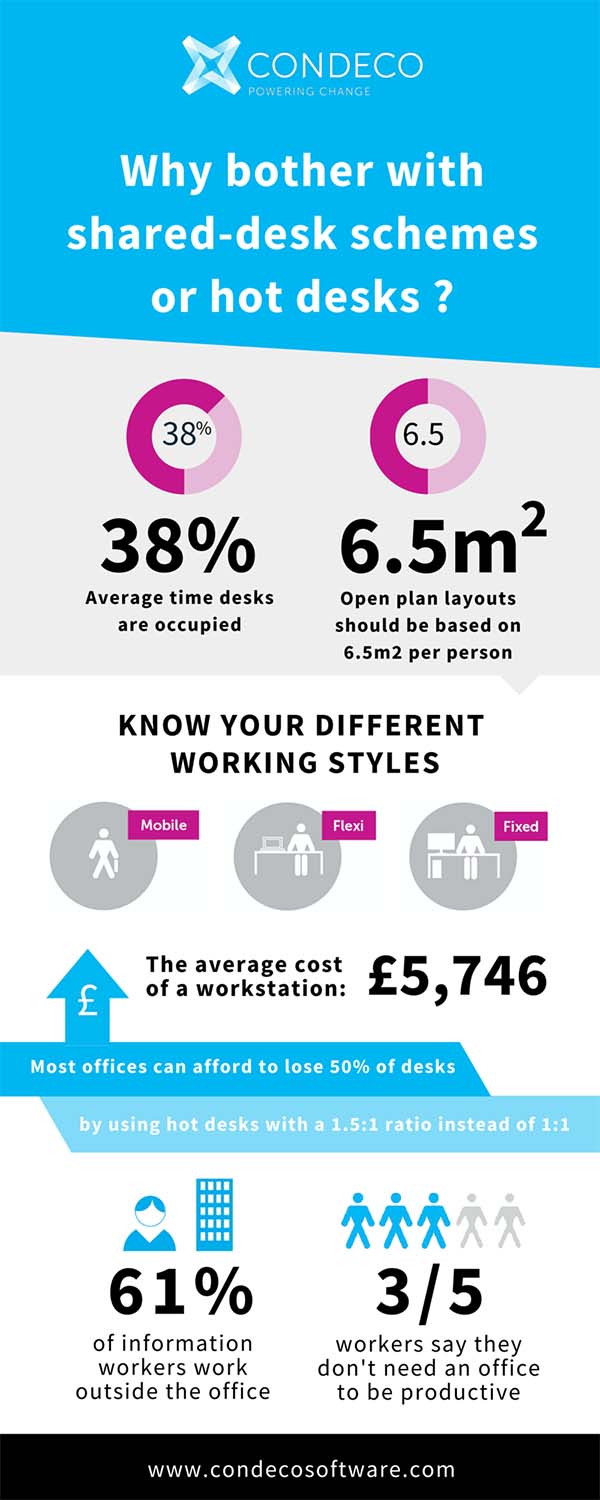Gone are the days of working a static 9-5 shift and staying desk-ridden for 8 hours straight. Today the working landscape is very different, the average time a desk is usually occupied is only 38%. So businesses are developing new ways of working to accommodate an increasingly agile and mobile workforce. This includes a rise in hot desking policies or shared-desk schemes which have some big business benefits.
Perfect for agile & flexible workforces
Most workplaces are creating (if they haven’t already) more flexible working environments and developing agile working strategies. This business transformation makes it easier for people to work wherever and whenever they need to, giving people the independence and responsibility to manage their own time effectively. Less micromanagement.
Hot desks or desk-sharing schemes allow your people to book workspace as and when they need it. People can also choose the type of space they need for certain activities, e.g. quiet areas for research and private areas for confidential work. Of course it’s not always a good idea to make everyone in the business use hot desks – for some people this can actually become counter-productive and very disruptive. So, in order to determine which of your people require a fixed desk or flexible desk, you can measure how much the spaces are used by undergoing occupancy sensor studies.
collaboration
Hot desking technology gives people the freedom to work wherever they want to, meaning they can sit with colleagues or projects teams to collaborate easily on tasks. This increases staff and business productivity, as people waste less time finding colleagues and sending lengthy email chains. People can have instant conversations and resolve problems or make decisions instantly, face-to-face.
building efficiency
 Shared-desk schemes let you increase the person to desk ratio. Traditional workplaces will have a 1:1 ratio where every person has a designated workstation – however with the average desk only getting used around 38%, this is causing businesses sickening amounts of wasted equipment and space. The average cost to operate a workstation is £5,746, multiply this across a whole organisation and you’re beginning to look at a substantial amount of money that’s being thrown away. By increasing the person to desk ratio, businesses can reduce unused resources while still accommodating employees and maintaining the same productivity levels.
Shared-desk schemes let you increase the person to desk ratio. Traditional workplaces will have a 1:1 ratio where every person has a designated workstation – however with the average desk only getting used around 38%, this is causing businesses sickening amounts of wasted equipment and space. The average cost to operate a workstation is £5,746, multiply this across a whole organisation and you’re beginning to look at a substantial amount of money that’s being thrown away. By increasing the person to desk ratio, businesses can reduce unused resources while still accommodating employees and maintaining the same productivity levels.
Desk-sharing schemes not only increase your workplace utilisation, but also improve your building’s efficiency. With office space accounting for the second highest operational cost after salaries, the potential savings by maximizing underused workspace is massive!
To manage shared-desk schemes effectively, you need workspace management technology to help avoid arguments over the new free space. Technologies like desk booking software and kiosks help to transform agile businesses successfully. People have the freedom to book their workspace in advance using an interactive floor plan and find a space that matches their needs. These tools can also enable people to find a desk close to their colleagues, improving collaboration.
And it doesn’t stop there, what about your mobile workers? Desk booking apps can allow people to make and manage bookings whilst they’re on the move.
Workplace management technology also provides a lot of data about your office space usage. Detailed reports help you understand your workspace better by highlighting user behaviour and areas of low usage. This means your corporate real estate team and facilities management team can effectively design and maximize the workspace you have.
So are hot desks and shared-desk schemes worth it? Definitely.



